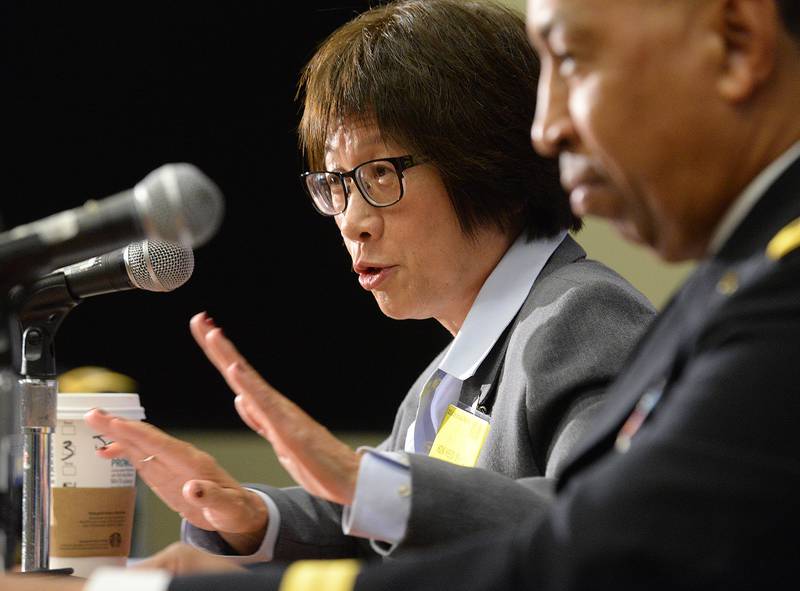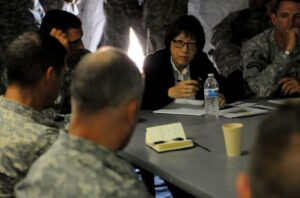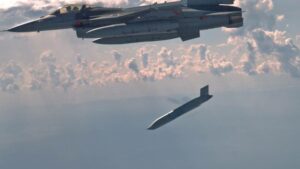WASHINGTON — The Pentagon is set to release a sweeping science and technology strategy focused on improving joint operations, rapidly pushing successful prototypes into production and strengthening the Defense Department’s research and development workforce.
Undersecretary of Defense Heidi Shyu said her team has completed the National Defense Science and Technology Strategy, which it’s been developing over the last year to outline how the department will harness emerging technology to counter threats from adversaries including China and Russia.
Speaking during a virtual National Defense Industrial Association event April 13, Shyu offered what she called a “sneak peek” of the document, which is awaiting approval from Defense Secretary Lloyd Austin. The report will be out “very shortly,” she said, without giving a date.
Informed by the Biden administration’s National Defense Strategy, released in October, the science and technology plan’s top focus is on supporting capabilities that improve the military’s ability to work together during a conflict.
“Everything we’ve been doing is very much focused in on joint warfighting capabilities and what we need to do as a joint force,” Shyu said. “The capability that we need to develop in that arena is what’s driving a lot of our focus, especially in prototyping [and] experimentation.”
She highlighted the Defense Department’s Rapid Defense Experimentation Reserve, or RDER, which is leading advanced demonstrations aimed at addressing high-need capability gaps. The first of those experiments is underway and focused on long-range fires.
A second priority outlined in the strategy is transitioning technology demonstrated in experimentation campaigns including RDER into the hands of military users. Shyu said her office is working closely with Pentagon’s acquisition and sustainment team quickly field those capabilities.
That focus aligns with a recommendation from the Atlantic Council’s Commission on Defense Innovation Adoption, which released an April 12 report that included 10 policy proposals to improve the Pentagon’s adoption of innovative technology. One of those ideas was to reduce the lag time between when a system is demonstrated and when it’s fielded by establishing a fund that military services can use to accelerate and scale new capabilities.
RELATED

Shyu highlighted a third emphasis of the strategy, which is to strengthen the department’s research and development “talent pipeline” through outreach to universities. She noted that her office’s Smart Scholarship Program has had success providing internship opportunities to college students who then graduate with a job offer at one of DoD’s laboratories. Participants are required to match the length of their internship with post-university service to the department.
“It’s a fee-for-service in the sense that if we paid for four years of your scholarship, you owe us four years of service within one of our entities,” she said. “I will tell you we have a very high retention rate even after the students fulfill their commitment to us.”
Courtney Albon is C4ISRNET’s space and emerging technology reporter. She has covered the U.S. military since 2012, with a focus on the Air Force and Space Force. She has reported on some of the Defense Department’s most significant acquisition, budget and policy challenges.
- SEO Powered Content & PR Distribution. Get Amplified Today.
- Platoblockchain. Web3 Metaverse Intelligence. Knowledge Amplified. Access Here.
- Minting the Future w Adryenn Ashley. Access Here.
- Source: https://www.defensenews.com/battlefield-tech/2023/04/13/pentagons-shyu-gives-sneak-peek-of-tech-strategy-focused-on-teaming/
- :is
- 1
- 10
- 2012
- 7
- 70
- a
- ability
- accelerate
- acquisition
- addressing
- Adoption
- advanced
- After
- AIR
- Air Force
- Aligns
- and
- approval
- April
- ARE
- Arena
- AS
- Association
- At
- austin
- awaiting
- BE
- between
- biden
- budget
- by
- called
- Campaigns
- CAN
- capabilities
- challenges
- China
- closely
- College
- commission
- commitment
- conflict
- Counter
- covered
- Date
- Defense
- demonstrated
- Department
- develop
- developing
- Development
- document
- doing
- driving
- during
- emerging
- Emerging Technology
- emphasis
- Engineering
- entities
- especially
- establishing
- Even
- Event
- field
- File
- fires
- First
- Focus
- focused
- For
- Force
- Fort
- from
- Fulfill
- fund
- gives
- Giving
- graduate
- Hands
- Have
- High
- Highlighted
- How
- http
- HTTPS
- ideas
- image
- images
- improve
- improving
- in
- included
- Including
- industrial
- Innovation
- innovative
- innovative technology
- Job
- joint
- jpg
- Last
- Last Year
- leading
- Length
- Lot
- Match
- Military
- most
- National
- Need
- New
- noted
- october
- of
- offer
- offered
- Office
- on
- ONE
- Operations
- opportunities
- outline
- outlined
- outreach
- paid
- participants
- pentagon
- plato
- Plato Data Intelligence
- PlatoData
- policy
- priority
- Production
- Program
- Proposals
- prototypes
- prototyping
- providing
- Pushing
- quickly
- rapid
- rapidly
- Rate
- Recommendation
- reduce
- release
- released
- report
- Reported
- reporter
- required
- research
- research and development
- retention
- Russia
- s
- Said
- Scale
- Science
- Science and Technology
- Screen
- Second
- secretary
- sense
- service
- Services
- set
- Shortly
- significant
- since
- smart
- some
- Space
- Space Force
- Strategy
- Strengthen
- strengthening
- Students
- success
- successful
- Supporting
- system
- team
- tech
- Technology
- Technology Strategy
- texas
- that
- The
- their
- Third
- threats
- Through
- time
- to
- together
- top
- transitioning
- u.s.
- Underway
- Universities
- us
- use
- users
- Virtual
- Visits
- What
- which
- WHO
- will
- with
- within
- without
- Work
- work together
- Workforce
- working
- year
- years
- Your
- zephyrnet












